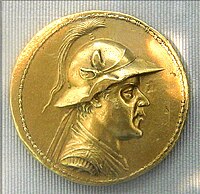Stater

The stater was an ancient coin of Greek or Lydian origin which circulated from about 700 BCE to 50 CE. It was also heavily used by Celtic tribes.
Original mintings of this coin such as practiced in Athens valued the stater at a tetradrachm (4 drachms), though issues at other places or times applied the word "stater" to a didrachm (2 drachm) coin. The stater was also minted at Corinth.[1] Staters were also struck in some of the Mediterranean islands such as Aegina and Kydonia. For example, One silver coin struck in Kydonia was that of a stater featuring the Minoan goddess Britomartis.[2]

 ) beneath. Reverse: Athena wearing Corinthian helmet. Qoppa symbolised the archaic writing of the city (
) beneath. Reverse: Athena wearing Corinthian helmet. Qoppa symbolised the archaic writing of the city ( όρινθος).
όρινθος).There also existed a "gold stater", but it was only minted in some places, and was mainly an accounting unit worth 20-28 drachms depending on place and time, the Athenian unit being worth 20 drachms. (The reason being that one gold stater generally weighed roughly 8.5 grams, twice as much as a drachm, while the parity gold:silver, after some variance, was established as 1:10) The best known types of gold staters are the 28 drachm Kyzikenos from Cyzicus, and the gold staters minted in Gaul that Gallic chiefs modelled after those of Philip II of Macedonia, which mercenaries brought back West after serving in his armies, or those of Alexander and his successors.
Line notes
References
- C. Michael Hogan, Cydonia, The Modern Antiquarian, Jan. 23, 2008 [1]
- William Smith, A Dictionary of Greek and Roman Antiquities, 1881, J. Murray
External links
- The British Museum Electrum 1/6 stater (650-600 BCE)
